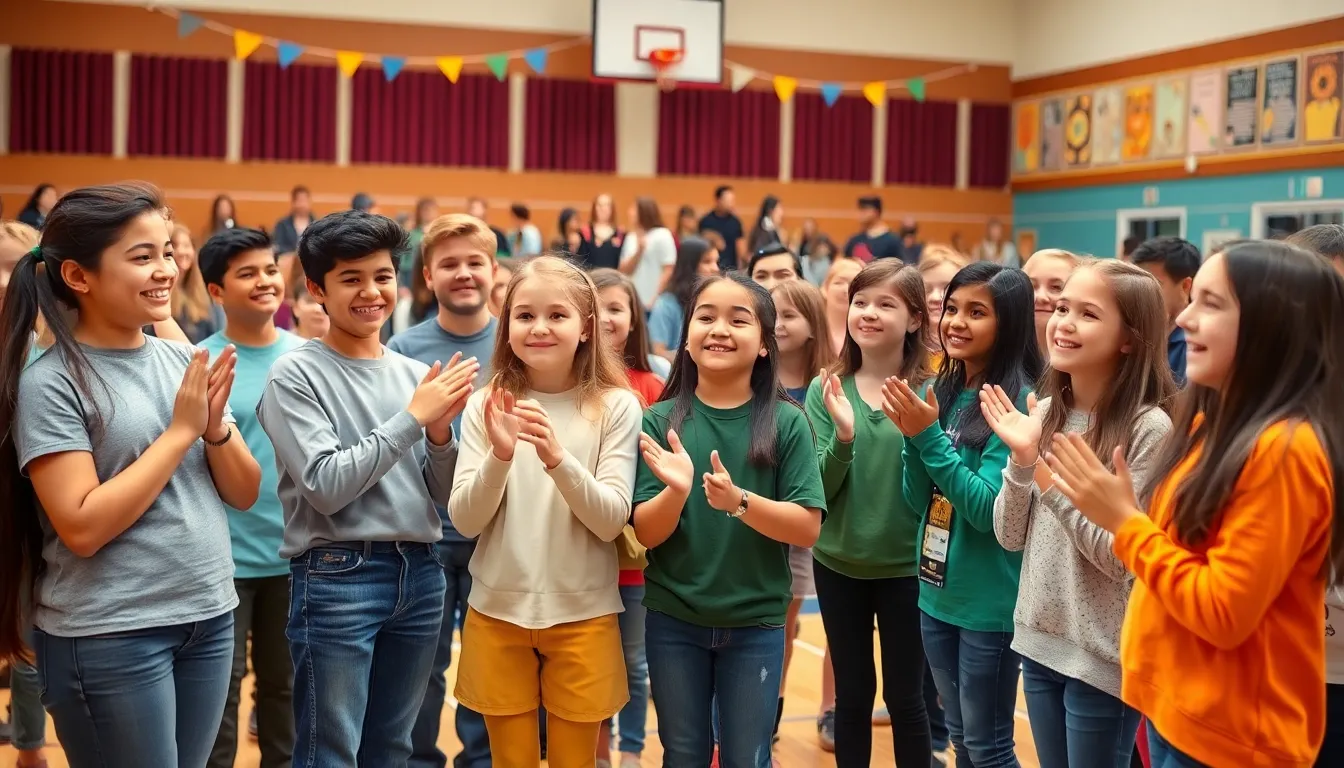School assemblies often get a bad rap. Students groan at the thought of sitting in a crowded gym, listening to yet another speech about the importance of “being your best self.” But what if these gatherings could be more than just a time-filler? What if they could spark enthusiasm, foster community, and even inspire a few laughs along the way?
Imagine a world where assemblies break the mold—where lively performances, interactive discussions, and a dash of humor transform the experience into something memorable. These events can be a powerful tool, bridging the gap between students and teachers while igniting a sense of school spirit. So, why not embrace the potential of school assemblies and turn them into the highlight of the week? After all, who wouldn’t want to trade in boredom for a burst of inspiration and a few good chuckles?
Table of Contents
ToggleOverview of School Assemblies
School assemblies serve as important gatherings within the educational environment. These events provide opportunities for students, teachers, and staff to come together, fostering a sense of community. Many schools utilize assemblies to communicate vital information, highlight achievements, and introduce new initiatives.
Engagement levels during assemblies often influence students’ perceptions. Interactive elements can transform a standard assembly into an enjoyable experience. Incorporating presentations, performances, or guest speakers can generate enthusiasm and capture attention.
Assemblies can also promote school spirit. Celebrating accomplishments in academics, sports, and arts encourages pride and unity among students. Recognizing student achievements in front of peers can inspire others to strive for excellence.
Discussions on relevant topics frequently take place during assemblies as well. Schools might cover subjects like mental health awareness, diversity, and community service. These conversations create a platform for students to learn and reflect on important societal issues.
Effective organization helps ensure assemblies run smoothly. Scheduling regular assemblies throughout the school year keeps communication consistent. Planning engaging activities or themes can maintain interest while reinforcing the school’s mission.
Schools that embrace creativity in assembly formats can enhance the overall experience. Setting aside time for students to showcase their talents adds excitement. Ultimately, viewed positively, school assemblies may become anticipated events that strengthen the school community.
Benefits of School Assemblies

School assemblies offer various advantages that contribute positively to the educational environment. They create opportunities for connection among students, teachers, and staff.
Fostering Community Spirit
Fostering a sense of community, school assemblies encourage students to bond over shared experiences. They provide a platform to celebrate achievements, thereby enhancing school pride. Students feel included when their accomplishments are recognized publicly. Assemblies also promote teamwork through collaborative activities, such as skits or group discussions. With each event, schools strengthen ties among different grades and cultivate a supportive atmosphere. This connectivity can lead to increased school spirit and a more cohesive educational experience.
Enhancing Student Engagement
Enhancing student engagement is a key benefit of school assemblies. Incorporating interactive elements grabs students’ attention and keeps them interested. Guest speakers often share unique insights, inspiring students to reflect on important topics. Diverse presentations can spark curiosity, encouraging discussion among peers. Additionally, performances can showcase students’ talents, providing a sense of accomplishment. When assemblies include various activities, they cater to different interests, thus appealing to a broader student audience. Engaging assemblies help maintain high energy levels, making school a more vibrant place for learning.
Types of School Assemblies
School assemblies come in various forms, each serving unique purposes and fostering different aspects of school life. Understanding these types can help schools enhance engagement and build community.
Educational Assemblies
Educational assemblies focus on informative content. These gatherings often feature presentations from teachers or guest speakers who discuss relevant topics such as science, history, or health. Students gain valuable insights through interactive discussions or demonstrations. Engaging students with multimedia presentations can spark interest in different subjects. Incorporating quizzes or interactive activities may promote participation and retain attention throughout the event. The goal remains to enrich students’ knowledge while reinforcing important academic concepts.
Cultural and Celebratory Assemblies
Cultural and celebratory assemblies highlight diversity and school achievements. These events celebrate various cultures within the student body, providing a platform for students to showcase their heritage. Performances, art displays, or cultural presentations create an inclusive atmosphere. Celebratory assemblies recognize student accomplishments in sports, academics, or community service, fostering school pride and unity. Such assemblies help to strengthen relationships among students and staff by creating a sense of belonging and appreciation. Incorporating music or dance can add excitement and enhance the celebratory vibe.
Best Practices for Organizing School Assemblies
Effective organization transforms school assemblies into engaging events. Prioritize planning and collaboration among staff members.
Planning and Coordination
Establish a timeline for assembly preparation. Identify goals that align with the school’s mission. Choose a suitable venue that accommodates all attendees comfortably. Assign roles to ensure everyone understands their responsibilities. Utilize resources efficiently to enhance the assembly experience. Consider incorporating technology, such as audio-visual equipment, to boost presentations. Gather feedback after each assembly to make improvements.
Involving Students and Staff
Encourage student participation in assembly planning. Host brainstorming sessions to solicit ideas from diverse groups. Foster a culture of involvement by allowing students to present their achievements. Invite staff to share insights that reflect the school’s values. Recognize the importance of diverse voices when selecting assembly topics. Involve student leaders to promote ownership of the process, ensuring assemblies feel relevant and relatable. Engage the entire school community to reinforce a sense of belonging and enthusiasm.
Transforming school assemblies into engaging events can significantly enhance the school experience for students and staff alike. By fostering a sense of community and promoting school spirit, these gatherings can become a source of pride and connection. Incorporating interactive elements and celebrating achievements not only captivates students but also strengthens relationships among peers and educators.
As schools embrace innovative approaches to assemblies, they can create vibrant environments that inspire enthusiasm and participation. With careful planning and collaboration, the potential for these events to become highlights of the school week is immense. Ultimately, reimagined school assemblies can play a pivotal role in shaping a positive school culture.




